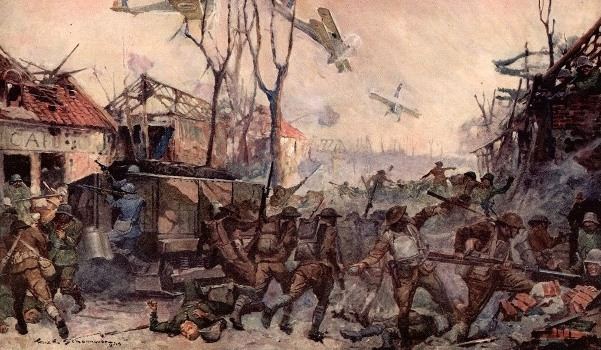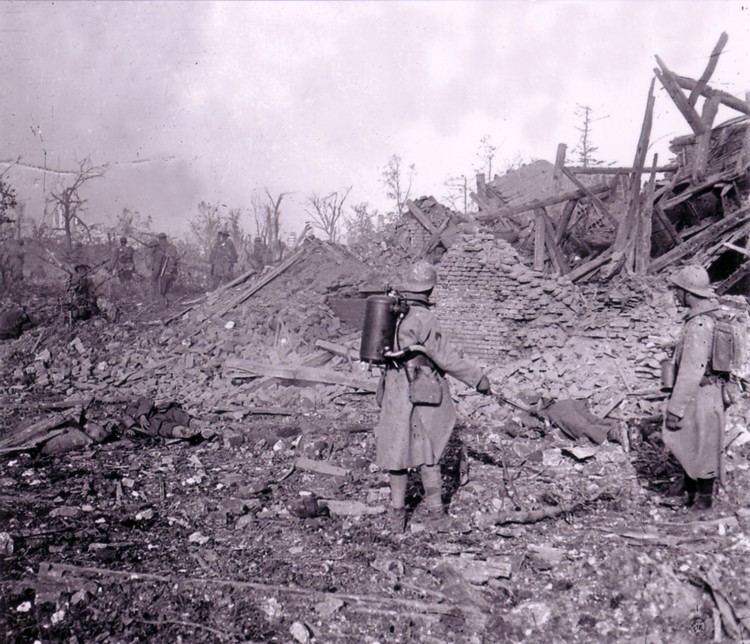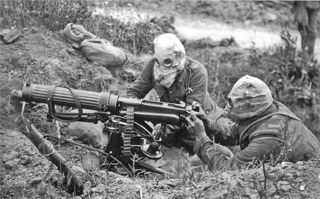~4,000 Unknown | Date 28 May 1918 Result Allied victory | |
Similar World War I, Battle of Château‑Thierry, Battle of Belleau Wood, Battle of Saint‑Mihiel, Battle of Soissons | ||
The Battle of Cantigny, fought 27–31 May 1918 was the first American battle and offensive of World War I. The U.S. 1st Division, the most experienced of the five American divisions then in France and in reserve for the French Army near the village of Cantigny, was selected for the attack. The objective of the attack was both to reduce a small salient made by the German Army in the front lines but also to instill confidence among the French and British allies in the ability of the inexperienced American Expeditionary Force (AEF).
Contents
- Wwi battle of cantigny diorama
- Background
- Capture of Cantigny
- Defense against German counterattacks
- Battle
- First Division
- McCormick
- Black Lions
- References

Wwi battle of cantigny diorama
Background

As the United States was technically not an ally, but rather a co-belligerent of the Allies, General John J. "Black Jack" Pershing, commanding the American Expeditionary Force, had for some time been resisting Allied efforts to integrate American divisions as they arrived into British and French armies. Instead, he wanted to launch them into battle as wholly American armies. Nevertheless, during the crisis of the Somme offensive end March, Pershing had offered to lend the Allies the five divisions that had arrived in France to help stem the German advance. The offer was gratefully accepted, and the U.S. 1st Division was ordered into the Picardy region to help General Marie-Eugène Debeney's French First Army, exhausted after halting the advance of General Oskar von Hutier, commanding the newly formed German Eighteenth Army. By April 23 the 1st Division was in place west of Cantigny, between the French 9th and 6th Corps.

The U.S. 1st Division, soon to be known throughout France as the "Big Red One" after its post-Armistice formation insignia of a red figure '1', had started to arrive in France on 26 June 1917. Composed of the 1st and 2nd Brigades (16th and 18th, 26th and 28th Infantry Regiments), 1st Division had been commanded by the able Major General Robert Lee Bullard since 14 December 1917. At the end of April the division had a strength of about 26,500 all ranks. On the eve of Cantigny total AEF strength amounted to 406,844 out of 667,000 U.S. military personnel in Europe.

The Americans desired to make a show of strength after the U.S. 26th Infantry Division was surprised in the line by a raid on Seicheprey in the Lorraine region on April 20–22. A division attack to retake Montdidier was contemplated but ruled out because it would also involve supporting attacks by French divisions on either side. On April 23 the 1st Division held the sector between the French 9th Corps and the French 6th Corps, with 1st Brigade's 18th Infantry Regiment holding the left-hand half of the line and 16th Infantry Regiment the right-hand—2nd Brigade being in reserve. The nationality of the troops opposite Cantigny could not long be concealed from the Germans: General Erich Ludendorff, appointed as First Quartermaster General (Quartiermeister), had given special orders that once Americans had been discovered in the line, they were to be subjected to immediate shelling with high explosives (HE) and gas shells to test out and possibly break their morale before they became hardened to the realities of trench warfare. On May 3 the Germans fired over 15,000 rounds of HE and gas shells at the 18th Regiment, causing 800 casualties, 200 of them killed. But the shelling was by no means one-way. The 1st Division's artillery brigade of one 155mm and two 75mm field regiments responded in kind, firing upwards of 10,000 rounds a day in counter-battery fire.

On May 15 Debeney ordered Bullard to capture Cantigny, a salient into the Allied lines (approximately 5 kilometres deep), which was defended by two battalions of German 82nd Reserve Division. The objective had little but tactical significance. The day chosen for the assault was May 28—one day after the date scheduled by the Germans for the start of the Aisne Offensive. Bullard had 13 days in which to prepare his plan and his men. The unit chosen for the honor of leading the first American offensive of World War I was the 28th Infantry Regiment.
On May 27 the 28th Regiment moved up to its assault lines and prepared for the following day's action. Around midnight the Germans sent out two strong patrols (over 30 men in each) to bring back American prisoners for interrogation. One of these patrols was caught and wiped out in no-man's land. The other reached the American lines in the Casablanca sector and after a brisk fight pulled back with one prisoner. The Americans immediately sent a patrol in pursuit, and this caught the German patrol before it reached its lines, rescued the American prisoner and destroyed the German patrol before returning to its own lines. That night's activities, including a German artillery bombardment, cost the Americans 50 casualties.
Capture of Cantigny
At its 06:45 H Hour, American troops left their jump trenches following an hour-long preparatory artillery barrage in which German counter-battery fire nullified the location of German artillery positions. A rolling barrage advancing approximately 100 meters every two minutes—giving the attacking troops plenty of time to keep up with it.
The 28th Infantry Regiment (Colonel Hansen Ely, commanding) plus three machine-gun companies and a company of engineers (3,564 men), captured Cantigny from the German Eighteenth Army. The village was situated on high ground surrounded by woods, making it an ideal target for German artillery.
Aiding the capture, the French provided air cover, 368 heavy guns, trench mortars, tanks, and flamethrowers. The advancing American infantry was aided by 10 Schneider tanks of the French 5th Tank battalion, used to eliminate German machine gun positions. With this support, and advancing on schedule behind a creeping artillery barrage, the 28th Infantry took the village in 30 minutes. It then continued on to its final objective, positions 2 kilometres (1.2 mi) from its jump-off point, just as the rolling barrage reached its final line, at 08:13.
Defense against German counterattacks
The first German counterattack, a small attack at 08:30 against the extreme right of the new American position, was easily repulsed, but German artillery bombarded the 28th Infantry for most of the day. At 17:10 the first large-scale counterattack took place, and a company of the 1st Battalion of the 26th Infantry commanded by Major Theodore Roosevelt, Jr. was used to reinforce a weak spot in the American line. Another German counterattack at 18:40 was also repulsed by a combination of artillery and Infantry defensive fire. A series of counterattacks over the next two days were also defeated by both American regiments, and the position held.
The Americans reduced the salient and expanded their front by approximately a mile. A minor success, its significance was overshadowed by the battle underway along the Aisne. The U.S. forces held their position with the loss of 1,603 casualties including over 300 killed in action; they captured 250 German prisoners. Matthew B. Juan, a Native American war hero, was killed during this battle.
The American success at Cantigny assured the French that American divisions could be entrusted in the line against the German offensive to take Paris. The victory at Cantigny was followed by attacks at Château-Thierry and Belleau Wood in the first half of June.
Battle
In 1923, The American Battle Monuments Commission (ABMC) administered 25 battle monuments, including one in the village of Cantigny that was dedicated on August 9, 1937. Along with this monument, a speech was given (at the invitation of General John J. Pershing) by Col. Robert R. McCormick, who had commanded the 1st Battalion of the 5th Field Artillery regiment at the battle. On one side of the memorial appears the inscription:
ERECTED BY THE UNITED STATES OF AMERICA TO COMMEMORATE THE FIRST ATTACK BY AN AMERICAN DIVISION IN THE WORLD WAR.On another side of the memorial appears the inscription:
THE FIRST DIVISION UNITED STATES ARMY OPERATING UNDER THE X FRENCH CORPS CAPTURED THE TOWN OF CANTIGNY ON MAY 28 1918 AND HELD IT AGAINST NUMEROUS COUNTERATTACKS.French translations of these inscriptions appears on the opposite sides of the monument.
First Division
A First Division Monument located along the road ½ mile southeast of Cantigny, is one of five erected by the First Division itself in 1919. The names of dead in the vicinity of Cantigny are engraved on the bronze plates. The monument is like a small concrete shaft, surmounted by a carved eagle of stone.
McCormick
In the center of Cantigny, a small monument was dedicated in 2005 by the McCormick Foundation to commemorate the participation of Colonel Robert R. McCormick in the historic 1st Battalion, 5th Field Artillery, the oldest American military unit on continuous active duty (dating back to the American Revolutionary War), then part of the First Division. In 1960, the McCormick Foundation opened the Cantigny War Memorial of the First Division, where materials from Chicago veterans were then collected.
Black Lions
On May 28, 2008, the 90th anniversary of the Battle of Cantigny, the McCormick Foundation and the Association of the 28th Infantry Regiment dedicated the statue "The Lion of Cantigny," an original bronze work by Stephen Spears depicting a doughboy of the regiment advancing through the village. The 28th Infantry was the assault regiment in the First Division's attack, the first major US battle of World War I. The regimental coat of arms is based on the lions in the heraldic arms of Picardy, where Cantigny is; the regiment's nickname is Black Lions.
